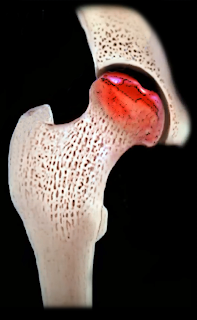Transient osteoporosis of the femoral head is not an
osteonecrosis of the femoral head. In transient osteoporosis, the symptoms are
usually more than the x-ray findings. It usually affects pregnant women, and it
also affects men during the 5th decade of life. On x-ray, you
probably will not find much. You may find osteopenia. The signal changes will
involve the femoral head and extend into the neck, and may include the
trochanteric area. In transient osteoporosis, there is no double density which
is seen in the MRI patients with osteonecrosis. Transient osteoporosis is not a
tumor, it is not an osteonecrosis, and it does not need surgery. Osteonecrosis
may be bilateral in about 80% of patients. Check the other hip even if the
patient is asymptomatic. Early diagnosis and treatment may improve the chances
for success of a head preserving surgical procedure, such as core decompression
or bone grafting. In late stages of osteonecrosis, the femoral head collapses and
cannot be saved. For the patient to have a good outcome, the femoral head will
need to be replaced at this late stage. MRI is usually the study of choice,
especially when the patient has persistent hip pain and the radiographs are
negative and the diagnosis of osteonecrosis of the femoral head is suspected,
especially if the patient has risk factors. On the T1 MRI, there will be a well-defined
band of low signal intensity usually within the superior anterior portion of
the femoral head. Decreased signal from the ischemic marrow, and there is a
single band-like area of low signal intensity (crescent sign). The crescent
sign represents the reactive interface between the necrotic and reparative
zone. The single line density demarcates the normal from the ischemic bone.
Double line sign is seen in T2 images. The subcortical lesion on T2 shows two
lines: low signal intensity line and high signal intensity line. The lesion
will show a high signal intensity inner border with a low signal intensity
peripheral rim (double line). The high signal intensity represents hyper
vascular granulation tissue. The size of the lesion is the most important
factor in determining the development of symptoms and the progression of the
disease. The best prognosis occurs in a small lesion with sclerotic margins.
The presence of bone marrow edema on the MRI is predictive of worsening of the
pain and future progression of the disease. Multifocal osteonecrosis is a
disease involving three or more sites such as the hip, the knee, the shoulder
and the ankle, occurs in about 3% of patients. A patient that presents with
osteonecrosis at a site other than the hip should undergo MRI of the hip to
rule out the asymptomatic lesion in the femoral head.
